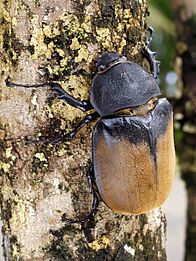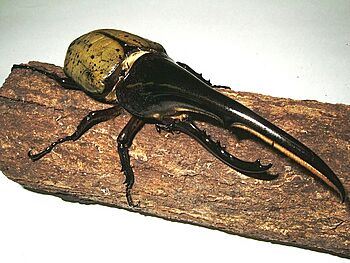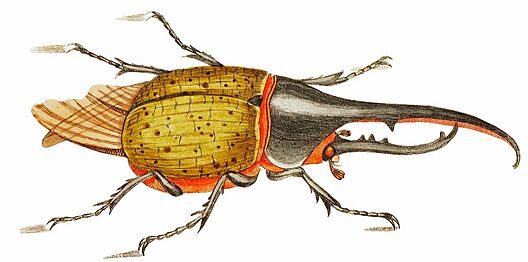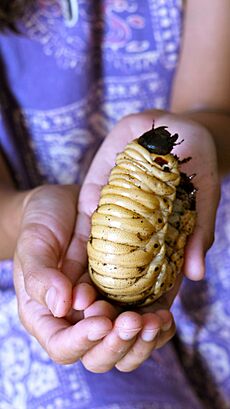Hercules beetle facts for kids
Quick facts for kids Hercules beetle |
|
|---|---|
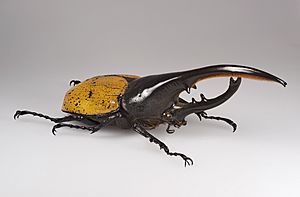 |
|
| Male Hercules beetle, Dynastes hercules ecuatorianus | |
| Scientific classification | |
| Genus: |
Dynastes
|
| Species: |
hercules
|
| Synonyms | |
|
|
The Hercules beetle (Dynastes hercules) is one of the most amazing insects in the world! It's a type of rhinoceros beetle that lives in the warm, wet rainforests of southern Mexico, Central America, South America, and the Lesser Antilles. This incredible beetle is known for being the longest beetle species on Earth. It's also one of the biggest flying insects you can find.
Contents
Meet the Hercules Beetle!
Imagine an insect named after a superhero! The Hercules beetle gets its name from Hercules, a famous hero from ancient Greek stories. Hercules was known for his incredible strength, and this beetle is super strong too!
Beetle Family Tree
The Hercules beetle belongs to a group called Dynastinae, which are also known as rhinoceros beetles. These beetles are part of an even bigger family called Scarabaeidae, or scarab beetles. There are several other species in the Dynastes group, but the Hercules beetle is definitely the most famous for its size. Scientists have also found different types, or subspecies, of the Hercules beetle.
What Does a Hercules Beetle Look Like?
Hercules beetles are truly impressive! Adult beetles, not counting their horns, can be between 50 and 85 millimeters (about 2 to 3.3 inches) long. They are also quite wide, measuring 29 to 42 millimeters (about 1.1 to 1.6 inches).
Males and Their Mighty Horns
Male Hercules beetles are the real giants. When you include their long horns, they can grow up to 173 millimeters (almost 7 inches) long! This makes them the longest beetles in the world. The size of a male's horn can vary a lot. It depends on things like how much food the beetle ate when it was growing up.
Only the male Hercules beetles have these amazing horns. They have one horn on their head and a much larger one on their body, near their head. The male's body is usually black. Their wing covers, called elytra, can be a cool olive-green color. They might also have some black spots.
Amazing Color Change!
One of the coolest things about the male Hercules beetle's wing covers is that they can change color! They have a slightly shiny look that can shift. In dry air, their wing covers are olive-green or yellow. But when the air gets humid, they can turn dark, almost black! This is a special trick called hygrochromism.
Females: No Horns, Still Cool!
Female Hercules beetles do not have horns. Their wing covers are usually all black and have tiny little dents. Sometimes, the last part of their wing covers might have the same color as the males.
Where Do Hercules Beetles Live?
You can find populations of Hercules beetles in the beautiful, lush rainforests. They live in both mountains and lowlands, from southern Mexico all the way down to Bolivia. They are also found in places like the Lesser Antilles, Trinidad and Tobago, Brazil, Ecuador, Colombia, and Peru. Scientists believe that the Dynastes group of beetles first came from South America.
The Hercules Beetle Life Cycle
The life of a Hercules beetle is a fascinating journey! While we don't know everything about them in the wild, we've learned a lot from beetles raised by people.
From Egg to Larva
Adult Hercules beetles usually mate during the rainy season, which is from July to December. After mating, a female beetle will lay her eggs about 30 days later. She can lay up to 100 eggs on the ground or on dead wood. The eggs hatch into tiny larvae (grubs) in about 28 days.
The larval stage is the longest part of their life, lasting up to two years! During this time, the larva grows through three stages, called instars. These larvae have yellow bodies and black heads. They can grow to be about 11.4 centimeters (4.5 inches) long and weigh over 100 grams! That's a big grub!
Growing Up: The Pupa Stage
After the larval stage, the beetle enters the pupal stage. This is like a resting stage where the larva changes into an adult beetle. This stage lasts about 32 days.
Adult Life
Once they become adults, Hercules beetles can live for about three to six months.
What Do Hercules Beetles Eat?
Hercules beetles have different diets depending on their life stage.
Larvae's Lunch
Young Hercules beetle larvae love to eat rotting wood. They spend their two-year growing period munching on this wood.
Adults' Favorite Foods
Adult Hercules beetles enjoy eating fresh and rotting fruit. They also like to drink tree sap. They use their strong mouthparts to cut into tree bark. This creates a small opening, like a straw, to sip the sweet sap. In captivity, they have been seen eating peaches, pears, apples, grapes, bananas, and mangoes.
How Do Hercules Beetles Behave?
These beetles have some interesting habits in their rainforest homes.
Night Owls of the Rainforest
Adult Hercules beetles are nocturnal, which means they are active at night. They search for fruit in the dark. During the day, they hide or burrow into the leaf litter on the forest floor.
Warning Sounds and Smells
If a Hercules beetle feels threatened, it can make a "huffing" sound. They do this by rubbing their abdomen against their wing covers. It's a warning signal to predators. Like many insects, they also use smells to communicate. Male beetles can sense a female nearby and will go looking for her!
Male Beetle Battles
Male Hercules beetles often fight each other. They do this to win a female's attention. They use their huge horns to battle! During a fight, a male will try to grab his rival between his horns. Then, he tries to lift and throw the other beetle. These fights can be tough, but the winner gets to be with the female.
Super Strength!
The Hercules beetle is famous for its strength. Some reports say it can carry up to 850 times its own body weight! However, scientific tests on smaller rhinoceros beetles show they can carry about 100 times their body weight. Even 100 times their weight is incredibly strong!
Hercules Beetles and Humans
Hercules beetles are not harmful to people. They don't damage crops or spread diseases. In fact, some people even keep them as pets!
Scientists have also found something cool in the waste of Hercules beetle larvae. It contains a special enzyme called β-mannanase. This enzyme can break down certain plant materials. It might even be used to make eco-friendly cleaning products in the future!
Helping the Environment
Hercules beetles are very helpful to the rainforest ecosystem. When they are larvae, they eat rotting wood. This helps to break down dead trees and plants. By doing this, they help to recycle important nutrients back into the soil. This process is called biodegradation and it keeps the rainforest healthy.
See also


